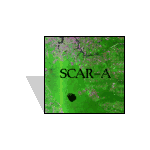Sulfates, Clouds and Radiation America

Fossil fuel burning creates urban and industrial aerosols that contribute to changes in the Earth’s energy budget. To address gaps in understanding the properties of these aerosols, the Smoke/Sulfate, Clouds, and Radiation – Atlantic (SCAR-A) experiment collected aerosol-related data in a July 1993 field campaign in the mid-Atlantic region of the eastern United States. Summers in this region are prone to hazy conditions related to urban and industrial pollution and provided an ideal stage for observing relevant aerosol properties. The primary objective of SCAR-A was to study the optical, physical, and chemical properties of sulfate aerosols in order to characterize the relationship between sulfate particles and clouds’ reflective properties.
SCAR-A was the first in a series of experiments that studied the atmospheric impacts of aerosols produced by various sources. The second experiment, SCAR-C, was conducted in September and October 1994 with the goal of studying the atmospheric effects of smoke aerosols from wild and prescribed fires in the U.S. Pacific Northwest. The third experiment, SCAR-B, was conducted in August and September 1995 with the goal of studying the atmospheric effects of biomass burning in Brazil.
During SCAR-A, the NASA ER-2 aircraft acquired remote sensing data using the Airborne Visible Infrared Imaging Spectrometer (AVIRIS), the enhanced MODIS Airborne Simulator (eMAS), and an RC-10 mapping camera. The ASDC houses SCAR-A data collected by the eMAS onboard the ER-2. In addition to the ER-2, the instruments on the University of Washington Convair C-131A aircraft measured in-situ meteorological, cloud, and aerosol variables to derive aerosol optical thickness. The C-131A conducted flights over six automatic spectral sun/sky scanning radiometers that provided ground-based remote sensing measurements of spectral optical thickness, aerosol phase function, and aerosol size distribution. A ground-based network of sun photometers measured aerosol optical depths and particle size distributions.
The results of SCAR-A expanded upon knowledge of how clouds and aerosols play a part in global change studies. Additionally, the research of SCAR-A was used to evaluate satellite remote sensing techniques against in-situ measurements to prepare for future data collection using the Moderate Resolution Imaging Spectrometer (MODIS) instrument, which launched onboard the Terra satellite in 1999.
Disciplines: Radiation Budget Field Campaigns
| Collection | Disciplines | Spatial | Temporal |
|---|---|---|---|
|
SCAR_A_ER2_MAS_1
Sulfates, Clouds and Radiation America NASA ER-2 Moderate Resolution Imaging Spectrometer (MODIS) Airborne Simulator (MAS) Data |
Aerosols, Clouds |
Spatial Coverage: (S: 35, N: 44.6), (W: -99.97, E: -70) |
Temporal Coverage: 1993-07-12 - 1993-07-29 |